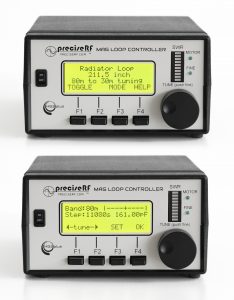Description
When the HG3 QRO 80m-30m option kit is installed on a HG3 QRO Magnetic Loop Antenna (MLA), full power on 80m, 60m, 40m and 30m operation is implemented. The HG3 QRO allows selection and tuning on these bands. Operation from 20m to 10m is not possible with the option installed.
Included:
• The LMR600 radiation loop
• Two each “L” SO239 connectors
• Six-inch SO239 extensions
• Two radiation loop spacers
• Two zip ties
• One Adel type clamp
• Arduino microprocessor with latest firmware.
Tuner, Controller, and Tripod Not Included

Tuning Considerations
Tuning the 80m-30m option is different from the 40m-10m option. While the band positions are factory preset, they may be different for your particular environment. The vacuum tuning capacitor is very high Q. One could easily miss the sharp dip in VSWR, especially on a wide band such as 80m. Good starting step points are: 80m 6360, 60m 16635, 40m 23742, 30m 27939. By carefully scanning for the lowest SWR for each band, using an antenna analyzer, and then using the band pre-set feature, your bands can be set to your specific environment. This provides repeatable band settings. Once set, you can auto tune as in 40m-10m bands. We recommend you use an antenna analyzer or a VNA, such as a Rig Expert AA-55 Zoom or equivalent, to set your user band preferences.
Two-turns versus one turn radiator
You might wonder why two turns rather than a single turn radiator loop? The 80m-30m option was tested as a single turn radiator. A single turn radiator is somewhat unwieldly. Also, to achieve resonance on the lower portion of 80m requires a considerably longer loop than simply stretching out the two-turn radiator. That is because the inductive reactance of a one-turn radiator is considerably lower than that of two-turn radiators. Our performance tests (below) bear out that the two-turn design and implementation is an excellent compromise in mechanical and performance attributes which provided an easy upgrade path to the HG3 QRO MLA system for an 80m-30m operator.
Performance
As tested in our lab using a RIGOL Real Time spectrum analyzer RSA 3030N and a PreciseRF RLB-I 50 ohm Return Loss Bridge. Your results may be different. Top trace is return loss bottom trace is VSWR.




<end>




Reviews
There are no reviews yet.